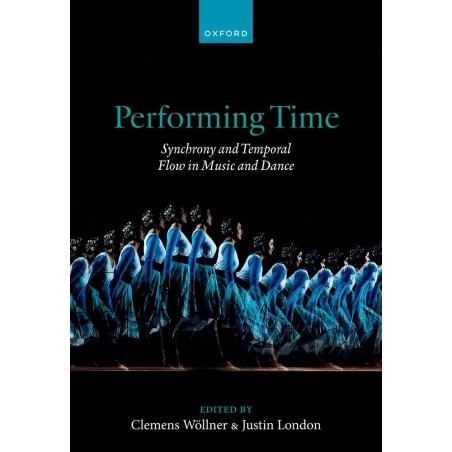Performing Time explores our experience of time in dance and music, from the perspectives of both performers and audience, and informed by the most recent research in dance science, musicology, neuroscience, and psychology.
CONTENTS
0 Wollner & London: Introduction to Performing Time
1 Foundations: The Flow of Time in Music and Dance
1 Bettina Blasing: Time experiences in dance
2 Mariusz Kozak: Varieties of musical temporality
3 Keith Doelling, Sophie Herbst, Luc Arnal & Virginie van Wassenhove: Psychological and neuroscientific foundations of rhythms and timing
4 Sylvie Droit-Volet & Natalia Martinelli: The psychological underpinnings of feelings of the passage of time
2 Duration, Tempo and Pacing in Performance and Perception
5 Justin London: What is musical tempo?
6 Renee Conroy: Telling time: Dancers, dancemakers, and audience members
7 Molly Henry & Sonja Kotz: Preferred tempo and its relation to personal sense of time and temporal flow
8 Coline Joufflineau: Time through the magnifying glass of slowness: a case study in Myriam Gourfink's choreography
9 Alexander Jensenius: Standing still together: Reflections on a one-year-long exploration of human micromotion
10 David Hammerschmidt: Spontaneous motor tempo: A window into the inner sense of time
11 Mari Romarheim Haugen: An embodied perspective on rhythm in music-dance genres
3 Synchrony: Keeping Together in Time
12 Guy Madison: Moving together in music and dance - features of entrainment and sensorimotor synchronisation
13 Werner Goebl & Laura Bishop: Joint shaping of musical time: How togetherness emerges in music ensemble performance
14 Julien Laroche, Tommi Himberg & Asaf Bachrach: Making time together: An exploration of participatory time-making through collective dance improvisation
15 Birgitta Burger & Petri Toiviainen: Time and synchronisation in dance movement
16 Simone Dalla Bella: Unravelling individual differences in synchronizing to the beat of music
17 Anne Danielsen: Shaping the beat bin in computer-based grooves
18 Matthew H. Woolhouse: The 'synchrony effect' in dance: how rhythmic scaffolding and vision facilitate social cohesion
4 Performance Time Experienced: Attention, Expectation and Groove
19 Clemens Wollner: Changes in psychological time when attending to different temporal structures in music
20 Pieter-Jan Maes & Marc Leman: Expressive timing in music and dance interactions: a dynamic perspective
21 Psyche Loui: Temporal aspects of musical expectancy and creativity in improvisation: A review of recent neuroscientific studies and an updated model
22 Anna Pakes: Experiences of time in boring dance
23 Jason Noble, Tanor Bonin, Roger Dean & Stephen McAdams: Evaluating the psychological reality of alternate temporalities in contemporary music: Empirical case studies of Gerard Grisey's Vortex Temporum
24 Kristina Knowles & Richard Ashley: Measuring experienced time while listening to music
25 Jan Stupacher, Michael Hove & Peter Vuust: The experience of musical groove: body movement, pleasure, and social bonding
5 Conclusions: Capturing Time in Performance and Science
26 Marc Wittmann: Embodied time: what the psychology and neuroscience of time can learn from the performing arts
27 Russell Hartenberger: Learning to feel the time: Reflections of a percussionist
28 Henry Daniel, Justin London: Performing and feeling time in contemporary dance
29 Kent Nagano, Clemens Wollner: Music is a unique artform because of the temporal aspect
30 Stewart Copeland & Daniel Levitin: Timing, tempo and rhythm: Evidence from the laboratory and the concert stage




